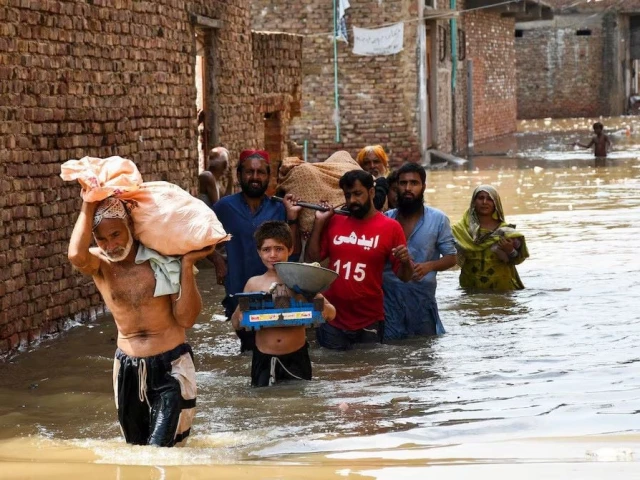Sudden recent floods have killed hundreds and uprooted thousands of lives in northern Pakistan, which ranks among the 10 most vulnerable countries in the world in the world
Northern Pakistan is in shock from the sudden floods devastating of the climate that killed hundreds earlier this month, destroying houses, infrastructures and livelihoods in scenes compared to the catastrophic floods of 2022.
Pakistan ranks among the 10 most vulnerable countries in the world, despite less than 1% of global greenhouse gas emissions. Experts warn that these floods and other calamities are no longer “rare disasters” and become routine shocks in a badly prepared country to resist them.
According to these experts, the emphasis must now be placed on adaptation, not on emission cuts.
Find out more: India alerts Pakistan to the coming threats of floods
“Floods are no longer rare disasters in Pakistan. They become routine shocks that people are preparing for each monsoon. Calling them” new normal “is not an exaggeration,” said the ecologist based in Karachi, Rafi-Ul-Haq.
Since mid-August, torrential rains, sudden floods and clouds have killed more than 460 people across the country, especially in cashmere administered by Pakistan and in the northern Gilgit-Baltistan region.
The northwest of Khyber Pakhtunkhwa was the least touched, where the swollen rivers, the mudslides and the collapsing houses buried whole families. Nationally, nearly 800 people have died in floods and landslides triggered by rain since the end of June.
Haq said that the intensity of rains and floods are accelerating due to climate change, global warming and the merger of glaciers. But human actions – unforeseen urbanization, deforestation, blocked watercourses, lax governance and low emergency responses – represents up to 60% of destruction.
“Pakistan cannot stop rain, but that can prevent a large part of suffering by fixing artificial vulnerabilities,” he said. “Floods will occur, but disasters are not forced to do so.”
Ahmed Kamal, a flood management expert based in Islamabad, described current floods as a “new standard”. The changing monsoon models, he said, intensified precipitation and created new devastation hotspots.
The Gilgit-Baltistan region, which houses imposing glaciers, has experienced alarming changes. Temperatures have increased regularly, accelerating the melting of glaciers and causing lighting flood floods. In May, the Chilas district recorded an unprecedented 49C (120F).
“We have our glaciers that melt very quickly, while the winters shrink,” said Kamal. “The snowfall was almost 50% lower than the average last year.”
Read also: More than 406 lives lost in KP floods since August 15
He also underlined the dangers of the intensification of cyclone threats in Pakistan, saying that the rise in temperatures on the sea surface in the Oman Sea has moved the activity of storms to the west, with cyclones more and more striking the coast since 2007.
At the same time, decades of deforestation – drawn by the demand for agricultural land and housing – have stripped the country of natural flood stamps. “This has multiplied the frequency and intensity of floods,” said Kamal.
Adaptation, resilience and governance
Experts argue that Pakistan must focus on strengthening resilience thanks to a mixture of natural and structural solutions.
“Given its economic limits, Pakistan priority must be adaptation and resilience rather than emission cuts,” said Haq.
He called to restore wetlands, mangroves and floodplaces to absorb excess water, clean the illegal construction of drainage channels and improve city drainage systems with green infrastructure.
He also underlined the need for resilient agriculture with floods supported by insurance and social security networks. “Steps at low cost such as cleaning pre-mousson drainage, early alert systems and community shelters can save lives immediately,” he said, highlighting the need to treat the weakness of land use and corruption.
Prime Minister Shehbaz Sharif recognized that “criminal negligence” by successive governments had enabled the construction of rivers and watershed beds. At a meeting of the cabinet last week, he promised to clean these encroachments.
“In addition to this, greater investments in the management of watersheds and resilient dwellings can follow international climate funding,” said Kamal.
The expert in the Imran SAQIB Khalid climate governance warned that Pakistan quickly takes measures, the future could provide food insecurity, water shortages and mass migration. “Science shows that if we continue on this trajectory, by the end of the century, we will reach warming nearly 2.5 ° C, which will wreak havoc,” he said.
Khalid also argued that Islamabad had to unite its forces with other low -emission nations to demand a more equitable world action and finance.
Kamal concluded on an optimistic note, saying: “The challenge is enormous, but the opportunity window is still there. With scientifically intelligent adaptation strategies, we could at least alleviate a large part of the devastation.”




